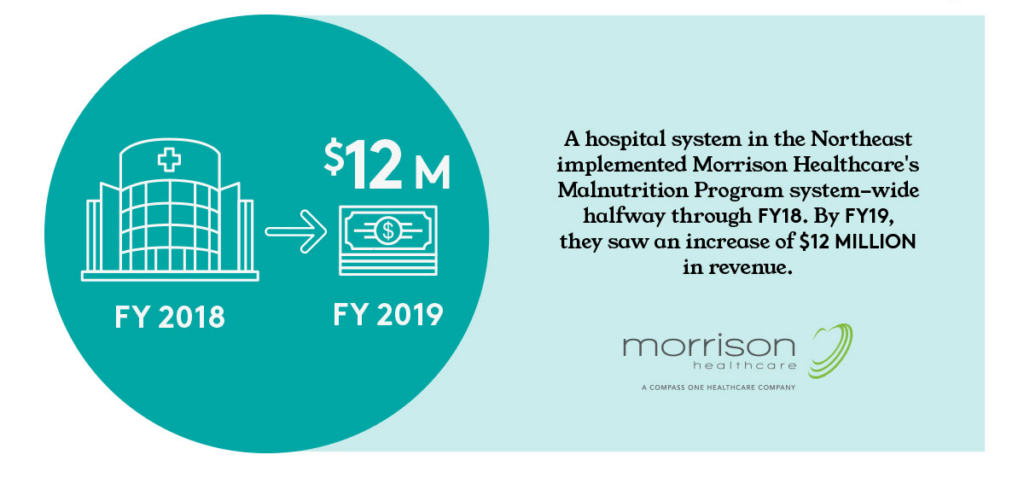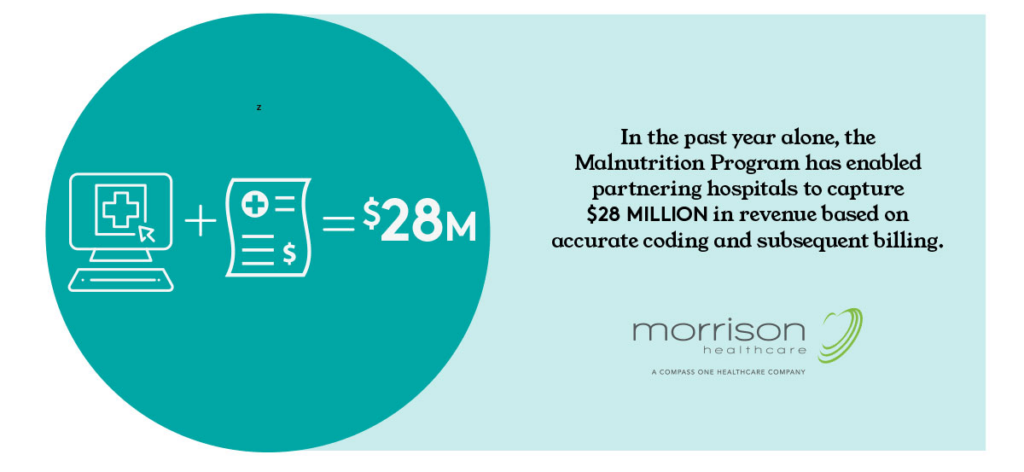When dietitian Jennifer Doley conducted a data review on malnutrition and coding practices at a local hospital, she discovered the hospital had missed on hundreds of thousands of dollars in reimbursements for Medicare patients.
In her audit, Doley found that the Registered Dietitian Nutritionists (RDNs) working at the hospital had identified 1,817 malnourished patients in just two years. An appalling 64% of these patients were not coded for malnutrition, preventing the hospital from receiving critical funding.

This hospital is not an isolated case. Morrison’s Clinical Nutrition team has conducted similar reviews across the country, which have revealed several missed revenue opportunities. As a solution, many of these clients have implemented our Malnutrition Program that focuses on early identification, intervention, and appropriate documentation of malnutrition.
In the past year alone, the Malnutrition program has improved patient outcomes and enabled partnering hospitals to capture $28 million in revenue based on accurate coding and subsequent billing.
The prevalence of malnutrition in our hospitals and health systems is staggering. Almost 50% of hospitalized patients in the United States are malnourished at the time of admission, leading to an increase in complications such as a higher risk for pressure injuries, infections, falls, and poor wound healing.
These complications often lead to longer stays and increased hospital costs associated with the treatment of malnourished patients.

Malnourished patients remain in the hospital at least two to three days more than their well-nourished counterparts. In her study, Doley determined that undernourished patients stayed an average of 5.3 days in the hospital. Since they were not coded for malnutrition, the Medicare severity level assigned upon discharge was lower than it should have been and was not accurately reflecting the patient’s illness. In fact, the actual Medicare payment that resulted from the assigned Medicare severity level was based on an expected length of stay of 3.5 days. Proper coding would have more accurately reflected the severity of their condition and would have resulted in an increase of reimbursement.
The cost of length of stay
Hospital leaders today face the challenges of reduced reimbursements and strict Medicare and Medicaid payment requirements.
Hospital costs associated with malnutrition are related to the average length of stay. Medicare establishes the expected average length of stay based on the final Medicare Severity-Diagnosis Related Group (MS-DRG), a system used to classify a Medicare patient’s hospital stay into various groups to facilitate payment of services.
When malnutrition is identified, coded, and treated appropriately, the assigned MS-DRG may change, indicating a longer expected length of stay. Such adjustments capture the resource intensity associated with providing care for malnourished patients more accurately.
Morrison’s Malnutrition program can effectively assess the impact of malnutrition in length of stay. A hospital with a fully-implemented Malnurition program was able to demonstrate a significant difference of 1.7 days between the expected and actual length of stay for malnourished patients based on malnutrition coding.
Another health system identified that their malnourished patients had an average length of stay of 7.8 days, compared to an average length of stay (ALOS) of 4.3 days for non-malnourished patients. This key observation led to the implementation of the Malnutrition program.
How does the Malnutrition program work?
The first step in implementing the Malnutrition program is to conduct a comprehensive tracer analysis on the ability of the clinical program to clearly identify all patients with or at risk for malnutrition upon admission to the hospital. Examination of the timeliness of nutritional assessments and establishment of multidisciplinary treatment plans follows. Then, we conduct an overview of the transition of care or discharge planning process for these patients. Additionally, we perform a gap analysis to evaluate how many patients are being missed throughout their hospitalized journey. This analysis allows us to identify the potential in outcomes and reimbursement.
Then, we provide program training that includes comprehensive materials for the clinical dietitians as well as guidance on how to implement the initiative. A hospital Malnutrition Committee with physicians, medical billing coders, nurses, dietitians, and others is also established to lay the foundation of a successful program.
Program training materials include:
- Practical Analysis of a Malnutrition Coding Program Learning Modules
- Competency Assessment and Documentation
- Nutrition Focused Physical Examination Training
- Clinical Policies and Procedures
- Order Writing Privileges Toolkit
After the successful implementation of the program at several locations, Morrison is now launching MyMalnutrition Tools, a proprietary software that helps track and measure the outcomes of the Malnutrition Program.
MyMalnutrition Tools offers an ideal data collection methodology in an environment where analytics and data security are more critical than ever.
The hospital where Doley performed her study went on to implement the Malnutrition program. She educated physicians and other clinical staff on accurately diagnosing malnutrition. She also worked with coders to ensure precise and more frequent coding.
If you’d like to learn how our malnutrition program can impact your average length of stay, please fill out the form below. Our corporate nutrition team could estimate the potential for increased reimbursement when our application is fully implemented.
This post is part two of a series of blogs dedicated to uncovering the impact of malnutrition on readmissions, length of stay, and revenue. Stay tuned for our third part!




